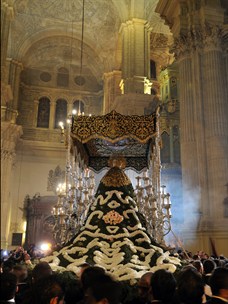The History of Holy Week in Malaga
 The history of Holy Week in Malaga has its roots in the sixteenth century and enjoyed its moment of maximum splendour in the heart of the Baroque era. The origin of Malaga’s brotherhoods date back to the years immediately following the Reconquista of Andalusia by the Catholic Monarchs. At that time, the brotherhoods played an important role in the work of the Christianization of the region initiated by Isabella of Castile and Ferdinand of Aragon. The oldest are the Confraternity of the Blood of Christ (1507) and the Brotherhood of the Vera Cruz (1505), which still exist. In the following decades, the congregations of Málaga began to stage, first with living characters and then with the use of statues and groups of statues, the drama of the Passion of Christ. Contrary to what happens today, in the past processions were not held every year, let alone during the entire span of Holy Week. The days allotted to the sacred parades were mostly on Wednesday, Thursday and Friday. In the mid-seventeenth century, the Andalusian city already had a considerable number of associations, often made up of the members of a craft guild (since the nineteenth century, however, congregations are identified with the district of residence). During the eighteenth century, however, several factors conspired to reduce their numbers: wars, famines, epidemics, floods and earthquakes deeply engraved themselves on the rites of Holy Week and on their participants. To complicate matters there was also the sale of church property, and finally, the Napoleonic invasion.
The history of Holy Week in Malaga has its roots in the sixteenth century and enjoyed its moment of maximum splendour in the heart of the Baroque era. The origin of Malaga’s brotherhoods date back to the years immediately following the Reconquista of Andalusia by the Catholic Monarchs. At that time, the brotherhoods played an important role in the work of the Christianization of the region initiated by Isabella of Castile and Ferdinand of Aragon. The oldest are the Confraternity of the Blood of Christ (1507) and the Brotherhood of the Vera Cruz (1505), which still exist. In the following decades, the congregations of Málaga began to stage, first with living characters and then with the use of statues and groups of statues, the drama of the Passion of Christ. Contrary to what happens today, in the past processions were not held every year, let alone during the entire span of Holy Week. The days allotted to the sacred parades were mostly on Wednesday, Thursday and Friday. In the mid-seventeenth century, the Andalusian city already had a considerable number of associations, often made up of the members of a craft guild (since the nineteenth century, however, congregations are identified with the district of residence). During the eighteenth century, however, several factors conspired to reduce their numbers: wars, famines, epidemics, floods and earthquakes deeply engraved themselves on the rites of Holy Week and on their participants. To complicate matters there was also the sale of church property, and finally, the Napoleonic invasion.
After the transformations experienced in the nineteenth century, starting in 1921 there was the desire to transform the Holy Week in Málaga into a grand and spectacular tourist event, thanks to advertising. In ten years, the brotherhoods doubled, the number of tronos tripled and the insignia and distinctive symbols of cofradías proliferated. After a long period of difficulty and only after the death of Francisco Franco (1975) was there a slow phase of recovery, culminating in the two subsequent decades. The entry of young people into brotherhoods led to a regeneration of the spirit of penance and the limiting of political interference in the rites of the Passion. In recent years, the Holy Week in Malaga is back in vogue, thanks to numerous cultural initiativesRecently, it was born the Museo de las Cofradías de la Semana Santa de Málaga: an exhibition space where visitors can admire the past and present of the Semana Santa (whose history is also conserved in the Diocesan Museum of Sacred Art) and the finest examples of the Baroque of Malaga, advertising and communication carried out by its organizers.
